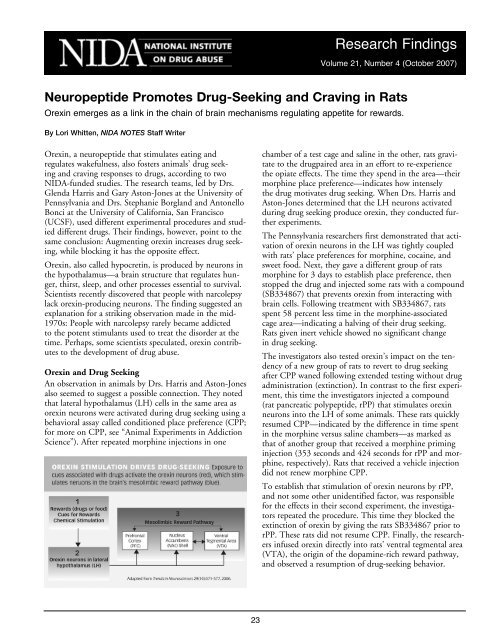Research on Cocaine - Archives - National Institute on Drug Abuse
Research on Cocaine - Archives - National Institute on Drug Abuse
Research on Cocaine - Archives - National Institute on Drug Abuse
Create successful ePaper yourself
Turn your PDF publications into a flip-book with our unique Google optimized e-Paper software.
Neuropeptide Promotes <strong>Drug</strong>-Seeking and Craving in Rats<br />
Orexin emerges as a link in the chain of brain mechanisms regulating appetite for rewards.<br />
By Lori Whitten, NIDA Notes Staff Writer<br />
Orexin, a neuropeptide that stimulates eating and<br />
regulates wakefulness, also fosters animals’ drug seeking<br />
and craving resp<strong>on</strong>ses to drugs, according to two<br />
NIDA-funded studies. The research teams, led by Drs.<br />
Glenda Harris and Gary Ast<strong>on</strong>-J<strong>on</strong>es at the University of<br />
Pennsylvania and Drs. Stephanie Borgland and Ant<strong>on</strong>ello<br />
B<strong>on</strong>ci at the University of California, San Francisco<br />
(UCSF), used different experimental procedures and studied<br />
different drugs. Their findings, however, point to the<br />
same c<strong>on</strong>clusi<strong>on</strong>: Augmenting orexin increases drug seeking,<br />
while blocking it has the opposite effect.<br />
Orexin, also called hypocretin, is produced by neur<strong>on</strong>s in<br />
the hypothalamus—a brain structure that regulates hunger,<br />
thirst, sleep, and other processes essential to survival.<br />
Scientists recently discovered that people with narcolepsy<br />
lack orexin-producing neur<strong>on</strong>s. The finding suggested an<br />
explanati<strong>on</strong> for a striking observati<strong>on</strong> made in the mid-<br />
1970s: People with narcolepsy rarely became addicted<br />
to the potent stimulants used to treat the disorder at the<br />
time. Perhaps, some scientists speculated, orexin c<strong>on</strong>tributes<br />
to the development of drug abuse.<br />
Orexin and <strong>Drug</strong> Seeking<br />
An observati<strong>on</strong> in animals by Drs. Harris and Ast<strong>on</strong>-J<strong>on</strong>es<br />
also seemed to suggest a possible c<strong>on</strong>necti<strong>on</strong>. They noted<br />
that lateral hypothalamus (LH) cells in the same area as<br />
orexin neur<strong>on</strong>s were activated during drug seeking using a<br />
behavioral assay called c<strong>on</strong>diti<strong>on</strong>ed place preference (CPP;<br />
for more <strong>on</strong> CPP, see “Animal Experiments in Addicti<strong>on</strong><br />
Science”). After repeated morphine injecti<strong>on</strong>s in <strong>on</strong>e<br />
23<br />
<str<strong>on</strong>g>Research</str<strong>on</strong>g> Findings<br />
Volume 21, Number 4 (October 2007)<br />
chamber of a test cage and saline in the other, rats gravitate<br />
to the drugpaired area in an effort to re-experience<br />
the opiate effects. The time they spend in the area—their<br />
morphine place preference—indicates how intensely<br />
the drug motivates drug seeking. When Drs. Harris and<br />
Ast<strong>on</strong>-J<strong>on</strong>es determined that the LH neur<strong>on</strong>s activated<br />
during drug seeking produce orexin, they c<strong>on</strong>ducted further<br />
experiments.<br />
The Pennsylvania researchers first dem<strong>on</strong>strated that activati<strong>on</strong><br />
of orexin neur<strong>on</strong>s in the LH was tightly coupled<br />
with rats’ place preferences for morphine, cocaine, and<br />
sweet food. Next, they gave a different group of rats<br />
morphine for 3 days to establish place preference, then<br />
stopped the drug and injected some rats with a compound<br />
(SB334867) that prevents orexin from interacting with<br />
brain cells. Following treatment with SB334867, rats<br />
spent 58 percent less time in the morphine-associated<br />
cage area—indicating a halving of their drug seeking.<br />
Rats given inert vehicle showed no significant change<br />
in drug seeking.<br />
The investigators also tested orexin’s impact <strong>on</strong> the tendency<br />
of a new group of rats to revert to drug seeking<br />
after CPP waned following extended testing without drug<br />
administrati<strong>on</strong> (extincti<strong>on</strong>). In c<strong>on</strong>trast to the first experiment,<br />
this time the investigators injected a compound<br />
(rat pancreatic polypeptide, rPP) that stimulates orexin<br />
neur<strong>on</strong>s into the LH of some animals. These rats quickly<br />
resumed CPP—indicated by the difference in time spent<br />
in the morphine versus saline chambers—as marked as<br />
that of another group that received a morphine priming<br />
injecti<strong>on</strong> (353 sec<strong>on</strong>ds and 424 sec<strong>on</strong>ds for rPP and morphine,<br />
respectively). Rats that received a vehicle injecti<strong>on</strong><br />
did not renew morphine CPP.<br />
To establish that stimulati<strong>on</strong> of orexin neur<strong>on</strong>s by rPP,<br />
and not some other unidentified factor, was resp<strong>on</strong>sible<br />
for the effects in their sec<strong>on</strong>d experiment, the investigators<br />
repeated the procedure. This time they blocked the<br />
extincti<strong>on</strong> of orexin by giving the rats SB334867 prior to<br />
rPP. These rats did not resume CPP. Finally, the researchers<br />
infused orexin directly into rats’ ventral tegmental area<br />
(VTA), the origin of the dopamine-rich reward pathway,<br />
and observed a resumpti<strong>on</strong> of drug-seeking behavior.
















